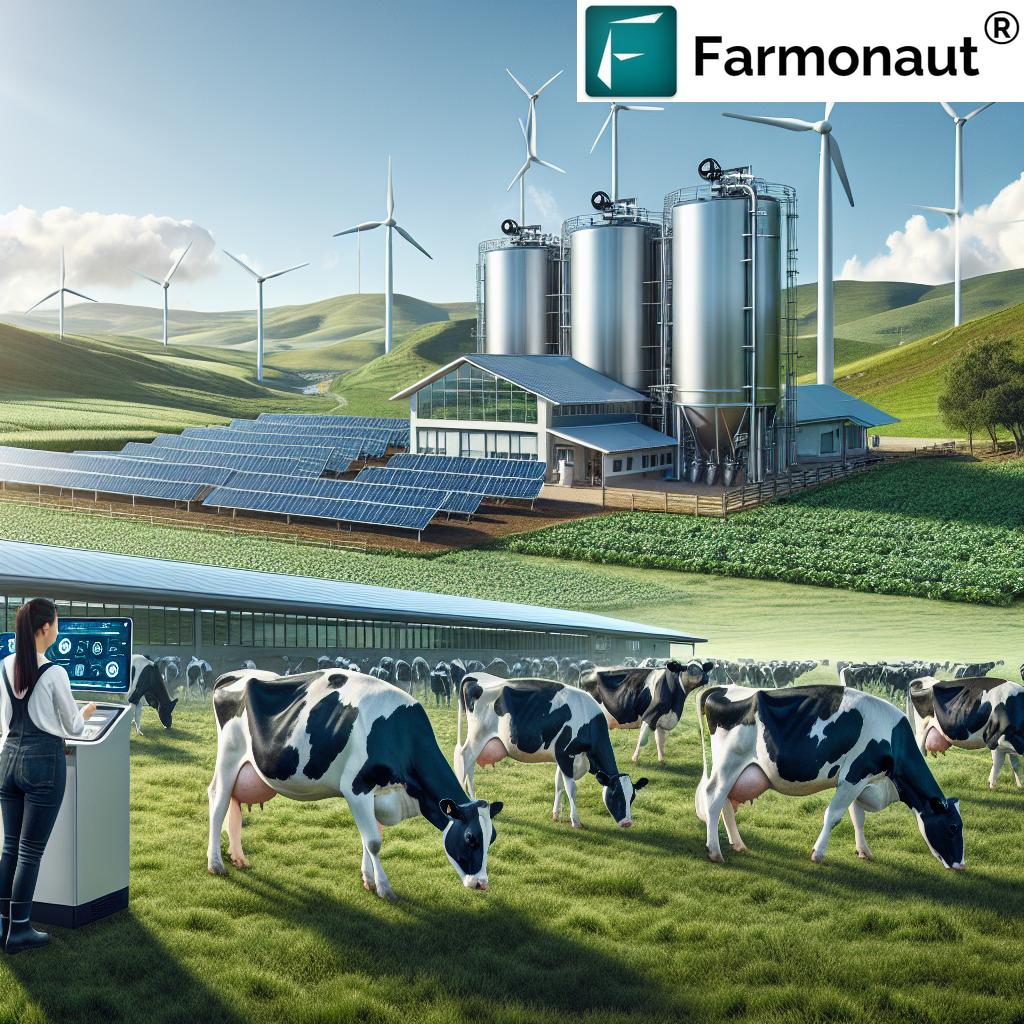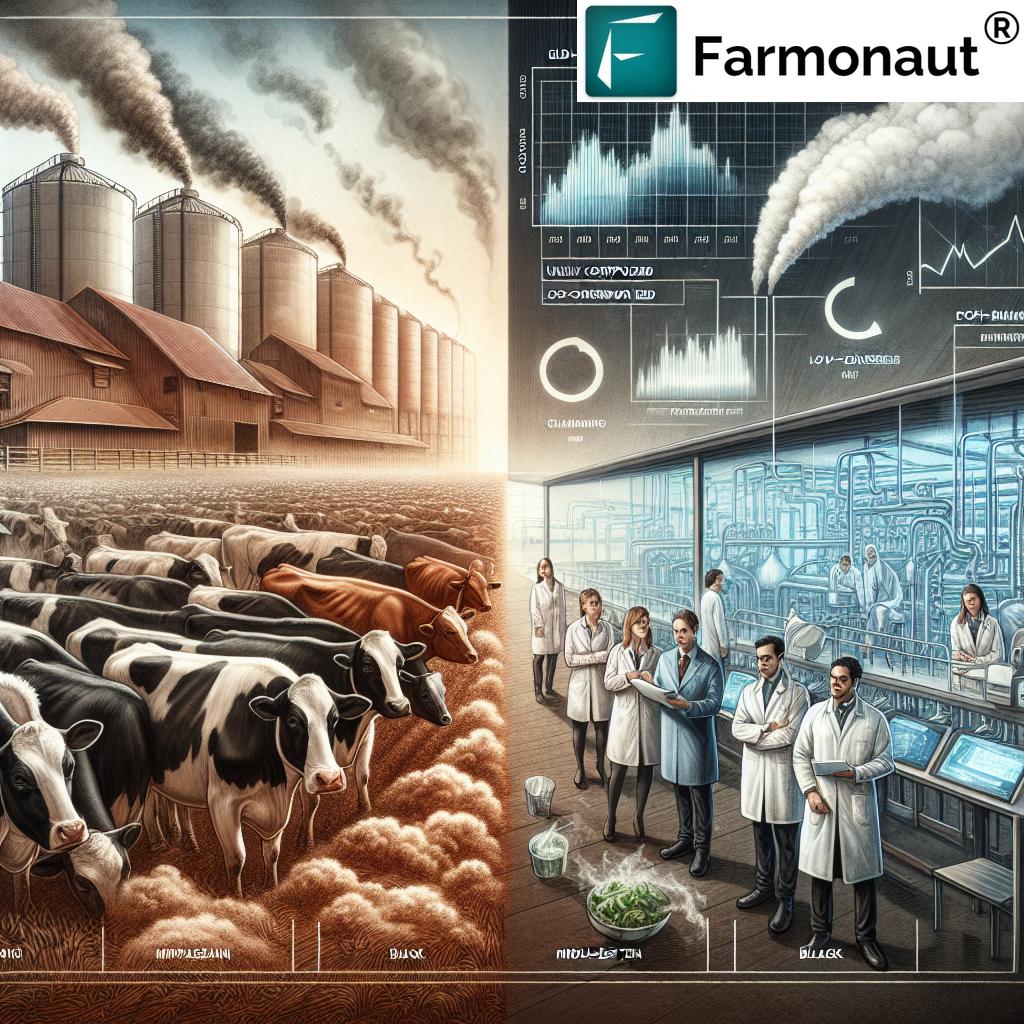Breaking News: Alberta’s Dairy Farms Lead Sustainable Livestock Revolution with Methane-Reducing Feed Additives
“Denmark leads in greenhouse gas mitigation, with dairy farms reducing methane emissions by up to 30% through innovative feed additives.”
Welcome to our latest industry update on sustainable livestock farming and agricultural climate solutions. Today, we’re excited to share groundbreaking developments in methane-reducing feed additives for dairy cows that are revolutionizing the agricultural sector, particularly in Alberta, Canada. As we delve into this topic, we’ll explore how innovative farming methods are shaping the future of climate-friendly livestock management and how digital tools are transforming the industry.

The Rise of Sustainable Livestock Farming
In recent years, the agricultural industry has been under increasing pressure to reduce its environmental impact while maintaining productivity. Livestock farming, particularly dairy production, has been a significant contributor to greenhouse gas emissions. However, Alberta’s dairy farms are now at the forefront of a sustainable livestock revolution, implementing cutting-edge feed additives that promise to dramatically reduce methane emissions.
These methane-reducing feed additives are a game-changer in the industry, offering a practical solution to one of agriculture’s most pressing environmental challenges. By incorporating these additives into cattle feed, farmers can significantly decrease the amount of methane produced during the digestive process of cows, known as enteric fermentation.
The Science Behind Methane-Reducing Feed Additives
Methane is a potent greenhouse gas, with a global warming potential 28 times that of carbon dioxide over a 100-year period. In dairy farming, methane is primarily produced when cows digest their food. The innovative feed additives work by altering the microbial environment in the cow’s rumen, the first compartment of their stomach, where most of the methane is produced.
These additives typically fall into several categories:
- Inhibitors: These compounds directly suppress the activity of methane-producing microorganisms in the rumen.
- Alternative Electron Acceptors: They provide a different pathway for hydrogen utilization, reducing methane formation.
- Bioactive Compounds: Natural substances like essential oils or plant extracts that modify rumen fermentation.
One of the most promising additives is 3-Nitrooxypropanol (3-NOP), which has shown remarkable results in reducing methane emissions without negatively impacting milk production or animal health.
Regulatory Approval and Implementation
The journey from laboratory to farm implementation for these feed additives has been rigorous. Regulatory bodies like the FDA (Food and Drug Administration) in the United States and Health Canada have been carefully evaluating these additives to ensure they are safe for animal health, do not affect food quality, and deliver on their environmental promises.
In Alberta, the provincial government has been working closely with dairy farmers and feed manufacturers to expedite the approval process while maintaining strict safety standards. This collaborative approach has positioned Alberta as a leader in sustainable dairy farming practices.
Impact on Dairy Farm Emissions
The implementation of methane-reducing feed additives in Alberta’s dairy farms has shown promising results. Early adopters have reported methane emission reductions of up to 30%, aligning with the success seen in countries like Denmark, which has been at the forefront of this technology.
“Regulatory-approved feed technology for cattle can decrease a dairy farm’s carbon footprint by approximately 25% within one year of implementation.”
This significant reduction in emissions not only contributes to global climate goals but also positions Alberta’s dairy industry as a leader in sustainable agriculture. The success in Alberta is expected to pave the way for wider adoption across Canada and North America.
Economic Implications for Farmers
While the environmental benefits are clear, the economic implications for farmers are equally important. Initially, there were concerns about the cost of implementing these new feed additives. However, many farmers are finding that the benefits outweigh the costs in several ways:
- Improved Feed Efficiency: Some additives have shown to improve overall feed utilization, potentially reducing feed costs.
- Carbon Credit Opportunities: As carbon markets develop, farmers may be able to sell carbon credits for their reduced emissions.
- Market Differentiation: Eco-friendly dairy products are increasingly sought after by environmentally conscious consumers.
- Government Incentives: Many governments are offering subsidies or tax breaks for implementing emission-reducing technologies.
For farmers looking to stay ahead of environmental regulations and market trends, investing in these feed additives is becoming increasingly attractive.
Global Context and Climate Goals
The advancements in Alberta’s dairy farms are part of a larger global effort to mitigate climate change in the agricultural sector. Countries around the world are setting ambitious targets for reducing greenhouse gas emissions, and agriculture is a key focus area.
Denmark, for instance, has been a pioneer in this field, with its dairy industry making significant strides in reducing emissions. The success in Alberta is now putting Canada on the map as a leader in sustainable dairy farming.
These efforts align with global climate goals set forth in agreements like the Paris Accord. By implementing these innovative solutions, the dairy industry is demonstrating that it’s possible to maintain productivity while significantly reducing environmental impact.

The Role of Digital Tools in Modern Farming
As we discuss these advancements in feed technology, it’s important to highlight the role of digital tools in modern farming practices. Precision agriculture technologies are playing a crucial role in implementing and monitoring the effects of these new feed additives.
Farmers are increasingly turning to digital platforms to manage their operations more efficiently. One such platform is Farmonaut, which offers advanced satellite-based farm management solutions. While Farmonaut doesn’t directly deal with feed additives, its technology can be invaluable for farmers implementing new sustainable practices.
Through Farmonaut’s platform, farmers can:
- Monitor crop health for feed production
- Track weather patterns to optimize feeding schedules
- Manage resources more efficiently, complementing the benefits of methane-reducing additives
For more information on how satellite technology can support sustainable farming practices, visit 
Challenges and Future Developments
While the progress in methane-reducing feed additives is promising, there are still challenges to overcome:
- Scalability: Ensuring sufficient production of these additives to meet industry demand.
- Long-term Effects: Continued research into the long-term impacts on animal health and milk quality.
- Consumer Acceptance: Educating consumers about the safety and benefits of these new technologies.
- Regulatory Harmonization: Aligning regulations across different countries to facilitate global adoption.
Researchers and industry leaders are continuously working on refining these additives and developing new solutions. Future developments may include:
- More potent and cost-effective additives
- Integration with other sustainable farming practices
- Customized additives based on individual farm conditions
Comparative Analysis of Methane-Reducing Feed Additives
| Feed Additive Name | Estimated Methane Reduction (%) | Regulatory Approval Status | Estimated Cost per Cow/Year | Countries Implementing | Potential Environmental Impact |
|---|---|---|---|---|---|
| 3-Nitrooxypropanol (3-NOP) | 30-40% | Approved in many countries | $50-$70 | USA, Canada, EU | High – Significant methane reduction |
| Seaweed (Asparagopsis taxiformis) | 50-80% | Under review | $100-$150 | Australia, New Zealand | Very High – Dramatic methane reduction, but scalability concerns |
| Essential Oils Blend | 10-20% | Generally recognized as safe | $30-$50 | Global | Moderate – Natural solution with fewer side effects |
| Nitrate Supplements | 20-30% | Approved in some countries | $40-$60 | Netherlands, Denmark | High – Effective, but requires careful management |
This table provides a clear comparison of different methane-reducing feed additives currently being used or researched in the dairy industry. It highlights the varying degrees of effectiveness, regulatory status, and potential environmental impact of each additive.
The Role of Technology in Implementing Sustainable Practices
As farmers adopt these new feed additives, the role of technology in monitoring and optimizing their implementation becomes crucial. Digital tools and precision agriculture technologies are essential for maximizing the benefits of these innovative solutions.
Farmonaut’s satellite-based farm management solutions can play a significant role in this process. While not directly involved in feed additive management, Farmonaut’s technology can help farmers:
- Monitor crop health for optimal feed production
- Track weather patterns to adjust feeding strategies
- Manage resources efficiently to complement methane reduction efforts
For more information on Farmonaut’s API capabilities, visit Farmonaut API. Developers interested in integrating these solutions can refer to the API Developer Docs.
The Future of Sustainable Livestock Farming
As we look to the future, the integration of methane-reducing feed additives with other sustainable farming practices will be key to achieving global climate goals in agriculture. This holistic approach to sustainable livestock management will likely include:
- Precision feeding techniques
- Improved manure management systems
- Renewable energy integration on farms
- Carbon sequestration through improved grazing practices
The success of Alberta’s dairy farms in implementing these feed additives is just the beginning. As more regions adopt these practices, we can expect to see a significant reduction in the global carbon footprint of the dairy industry.
Conclusion
The sustainable livestock revolution led by Alberta’s dairy farms marks a significant milestone in our journey towards climate-friendly agriculture. By embracing innovative feed additives and leveraging digital technologies, the industry is demonstrating that it’s possible to balance productivity with environmental stewardship.
As we continue to face the challenges of climate change, these advancements in livestock management offer hope and a practical path forward. They show that with innovation, collaboration, and the right tools, we can create a more sustainable future for agriculture and our planet.
For farmers and agribusinesses looking to stay at the forefront of these developments, tools like Farmonaut can provide valuable support in implementing and optimizing sustainable practices. Explore Farmonaut’s solutions:
Farmonaut Subscriptions
FAQ Section
Q: What are methane-reducing feed additives?
A: Methane-reducing feed additives are supplements added to cattle feed that help decrease the amount of methane produced during the digestive process of cows. They work by altering the microbial environment in the cow’s rumen, where most methane is produced.
Q: How effective are these additives in reducing methane emissions?
A: The effectiveness varies depending on the specific additive, but some have shown to reduce methane emissions by up to 30-80%. For example, 3-Nitrooxypropanol (3-NOP) has demonstrated methane reductions of 30-40% in dairy cows.
Q: Are these feed additives safe for cows and milk production?
A: Yes, the additives that have received regulatory approval have been thoroughly tested for safety. They do not negatively impact animal health or milk production. However, long-term studies are ongoing to ensure continued safety and efficacy.
Q: How do these additives contribute to global climate goals?
A: By significantly reducing methane emissions from dairy farms, these additives help decrease the overall greenhouse gas emissions from the agricultural sector, which is a key component in achieving global climate goals set forth in agreements like the Paris Accord.
Q: What role does technology play in implementing these sustainable practices?
A: Technology plays a crucial role in monitoring and optimizing the use of these feed additives. Digital tools and precision agriculture technologies, like those offered by Farmonaut, help farmers manage their operations more efficiently, complementing the benefits of methane-reducing additives.
Q: Are there any economic benefits for farmers adopting these feed additives?
A: While there may be initial costs, farmers can benefit from improved feed efficiency, potential carbon credit opportunities, market differentiation for eco-friendly products, and government incentives for implementing emission-reducing technologies.
Q: How can farmers get started with implementing these sustainable practices?
A: Farmers interested in adopting methane-reducing feed additives should consult with their local agricultural extension services, veterinarians, and feed suppliers. Additionally, they can explore digital tools like Farmonaut to support their transition to more sustainable farming practices.





